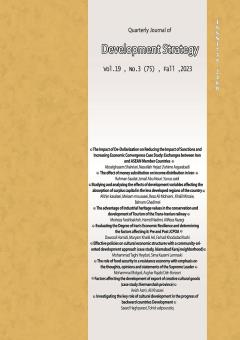Evaluating the Degree of Iran's Economic Resilience and determining the factors affecting it: Pre and Post JCPOA
Subject Areas :Farhad khodadad 1 , داود حمیدی 2 , Maryam Khalili Asl 3 *
1 - Central Organization of Payam Noor University of Tehran
2 -
3 -
Keywords: Keywords: Economic resilience, JCPOA, composite index, complexity,
Abstract :
Dawood Hamidi Maryam Khalili Asl Farhad Khodadad Kashi Abstract In this research, the Iran's economy resilience before and after the JCPOA and the factors affecting it are evaluated. A composite index is used to measure Iran's economic resilience. This index covers the three dimensions of economic stability, welfare effects, concentration and export variety. The results confirm that Iran's economic resilience has changed from 0.31 to 0.51 during the period 1995-2016. It should be mentioned that the size of this index decreased to its lowest level in 2013 due to the sanctions imposed by the United Nations. In addition, variables such as economic complexity, economic freedom, good governance and capital formation have positive and significant effect on the Iran's economy resilience, while the openness of the economy had a negative effect on it. The estimation results of the model show that JCPOA has had a positive and significant effect on Iran's economy resilience. This agreement has had a significant effect on Iran's economy and world markets by canceling and removing nuclear sanctions against Iran. The implementation of this agreement has facilitated the entry of technology and investment of the world's oil companies in Iran.
- ابلاغ سیاستهای کلی اقتصاد مقاومتی، http://www.leader.ir .
- اسدی، علی (۱۳۹۳)، "نظام اقتصاد اسلامی الگویی کامل برای اقتصاد مقاومتی"، فصلنامه سیاست-های راهبردی و کلان، دوره 2، شماره 5، ص 39-25.
- امیری طهرانی زاده، سیدمحمدرضا (۱۳۹۴)، "مبانی سیستمی اقتصاد مقاومتی"، جستارهای اقتصادی ایران، دوره 12، شماره 23، ص51-33.
- تاری، فتح اله و کاویانی، زهرا (1392)، "اقتصاد مقاومتی و مؤلفه¬های آن"، فصلنامه سیاست کلان، دوره 2، شماره 2، ص 47-27.
- دانش جعفری، داود و کریمی، سمانه (1393)، "نفت ، برنامه ششم توسعه و اقتصاد مقاومتی"، فصلنامه سیاست¬های راهبردی و کلان، دوره 2، شماره 8، ص 35-1.
- دادرس مقدم، امیر، کریم، محمدحسین و رهنما، علی (1399)، "عوامل مؤثر بر تاب¬آوری اقتصادی در مناطق آزاد تجاری ایران"، فصلنامه سیاست¬های راهبردی و کلان، دوره 8، شماره 2، ص 289-264.
- سیف، اله مراد (1391)، "الگوي پيشنهادي اقتصاد مقاومتي جمهوري اسلامي ايران (مبتني بر ديدگاه مقام معظم رهبري)"، فصلنامه آفاق امنیت، دوره 5، شماره 16، ص22-5.
- شیخی، عبدالمجید (1393)، "رابطه اقتصاد مقاومتی با علم اقتصاد اسلامی"، فصلنامه علوم انسانی اسلامی صدرا، ویژه نامه اقتصاد مقاومتی، تهران.
- غیاثوند، ابوالفضل و عبدالشاه، فاطمه (1394)، "مفهوم و ارزیابی تاب¬آوری اقتصادی ایران"، فصلنامه پژوهشنامه اقتصادی، دوره 15، شماره 59، ص 187-161.
- فرزین، محمدرضا، معمارنژاد، عباس و غلامی، الهام (1397)، "بررسی آثار عوامل مؤثر بر تاب¬آوری اقتصادی در ایران و کشورهای منتخب: رویکردی بر روش داده¬های تابلویی با ضرائب متغیر"، فصلنامه اقتصاد کاربردی، دوره 8، شماره 24، ص 22-14.
- گجراتی، دامودار (1393)، مبانی اقتصادسنجی، ترجمه: حمید ابریشمی، انتشارات دانشگاه تهران.
- نوراحمدی، محمدجواد (1393)، "اقتصاد مقاومتي ضرورتي اجتناب¬ناپذير برای نظام جمهوری اسلامي ايران"، فصلنامه علوم انسانی اسلامی صدرا، ویژه نامه اقتصاد مقاومتی.
- Briguglio, L., Cordina, G., Farrugia, N. and Vella, S. (2008). "Economic Vulnerability and Resilience Concepts and Measurements" UNU-WIDER, Research Paper No. 2008/55.
- Bavetta S. (2004). Economic Freedom and its Measurement. The Encyclopedia of Public Choice. Springer, Boston, MA.
- Finger, J. M. and M. E. Kreinin (1979). "A measure of ‘export similarity’ and its possible uses" the Economic Journal, 89: 905-12.
- FM Global (2017), Resilience Index Annual Report, Pentland Analytics.
- Hallegatte, S. (2014). "Economic Resilience: Definition and Measurement" Policy Research Working Paper, World Bank.
- Hidalgo, C. A. and Hausmann, R. (2009). "The Building Blocks of Economic Complexity" Proceedings of the National Academy of Sciences, 106(26):10570-5.
- Hill, E. W., Wial, H. and Wolman, H. (2008). "Exploring Regional Economic Resilience" Working Paper, no. 2008-04.
- Hennebry, B. (2020). "The determinants of economic resilience in rural regions. An examination of the Portuguese case" Miscellanea Geographica, 24(1), 24-29.
- Johnson, Richard A., and Dean W. Wichern (1992). Applied Multivariate Statistical Analysis, Third Edition, Upper Saddle River, New Jersey: Prentice-Hall, Inc.
- Jolles, M., Meyermans, E. and Vasicek, B. (2023). "Determinants of macroeconomic resilience in the euro area: An empirical assessment of national policy levers" Quarterly Report on the Euro Area, 17(3), 27- 46.
- New Economics Foundation (2015). Financial System Resilience Index Building a strong financial system, Friends Provident Foundation.
- OECD (2008). Handbook on Constructing Composite Indicators: Methodology and User Guide – ISBN 978-92-64-04345-95.
- Rose, A. and Krausmann, E. (2013). "An economic framework for the development of a resilience index for business recovery" International Journal of Disaster Risk Reduction,5: 73-83.
- Svoboda, O. and Klementova, T. (2013). Empirical Model of the Regional Economic Resilience, Recent Advances in Energy, Environment and Financial Planning.
- The Atlas of Economic Complexity (2018). Center for International Development at Harvard University, https://atlas.cid.harvard.edu.
- The Heritage Foundation (2018). Economic Data and Statistics on World Economy and Economic Freedom, https://www.heritage.org/index/explore?view=by-region-country-year.
- The International Monetary Fund (IMF) (2018). World Economic database.
- United Nations Conference on Trade and Development (UNCTAD) (2018). World Economic Situation and Prospects, https://www.un.org.
- United Nations Conference on Trade and Development (UNCTAD) (2018). statistics, http://unctadstat.unctad.org.
- United States Agency for International Development (USAID) (2018). Measuring Resilience in USAID, https://www.usaid.gov.
- WGI (2018). Worldwide Governance Indicators, http://www.govindicators.org.
- World Bank Open Data (2018). World Bank group, https://data.worldbank.org
- World Economic Forum (2013). an Initiative of the Risk Response Network, Global Risks 2013, Eighth Edition.
- Wang, X. and Li, M. (2022). "Determinants of Regional Economic Resilience to Economic Crisis: Evidence from Chinese Economies" Sustainability, 14(2): 809.
- Zhiwei, D., Hongou, Z., Yuyao, Y., Lixia, J. and Qian, X. (2019). "Urban shrinkage and growth: Measurement and determinants of economic resilience in the Pearl River Delta" Journal of Geographical Sciences, 29(8): 1332-1345.

